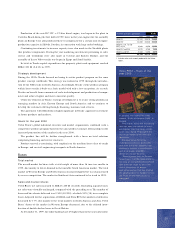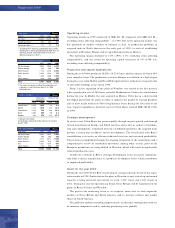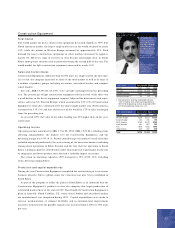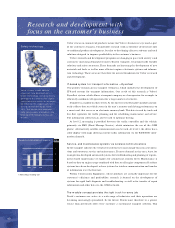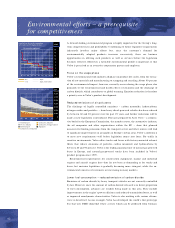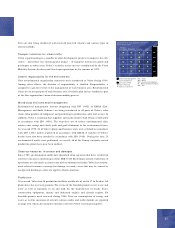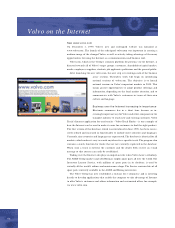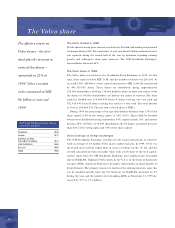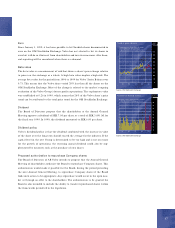Volvo 1999 Annual Report Download - page 43
Download and view the complete annual report
Please find page 43 of the 1999 Volvo annual report below. You can navigate through the pages in the report by either clicking on the pages listed below, or by using the keyword search tool below to find specific information within the annual report.
41
must also be accomplished in a more efficient, simpler and less resource-demanding
manner than currently.
Volvo’s trucks are therefore increasingly being built according to a module concept
which is defined as “a number of components and interfaces that are organized,
developed, produced and maintained in modules that can be flexibly combined to
build a specified product family.” The truck is thus divided into building blocks or
modules. Each module has well-defined interfaces with other modules, allowing the
modules to be combined into customized transport solutions.
The module concept also involves new work methods in product development. A
global, cross-functional team of engineers with a wide range of expertise is responsible
for developing each module. The team develops modules in parallel and can work with
several truck models simultaneously. Sub-suppliers also work with the module team on
technical and product development. Suppliers are assuming increasingly greater
responsibility for development of certain truck modules.
With the module concept, Volvo gains many advantages. Modules create flexibility,
allowing a broad range of products to be offered with the fewest parts possible. This
results in economies of scale, improved quality, shorter lead times and lower costs for
both Volvo and its customers.
Four years ago, Volvo Trucks had six different product families, and about 48,000
active parts, for global production of heavy trucks. By 2001, the intent is that all Volvo
heavy trucks will be based on a single family, the FH family, and consist of about
25,000 parts.
Truck’s FH model, which was introduced on the market as early as 1993, is Volvo’s
most significant example of the module concept. During 1999, close to 70,000 Volvo
heavy trucks were based on the FH family (FH, FM, VN, NH), one of the world’s
largest volumes for a heavy truck family.
Volvo Buses and Volvo Construction Equipment also use the module concept in
their production.
Research in diesel com bustion
Diesel combustion is an important area of research for the Volvo Group. This work is
conducted both within the Group, as well as in cooperation with external companies
and universities. The main challenge for researchers lies in being able to combine
continued sharp reductions of nitrous oxides (NOx) and particles (PM) with favorable
development of the engine’s other values in the form of low fuel consumption and
costs, high reliability and long operational life.
A new method of casting that will produce a material with significantly higher
tensile strength will be introduced at Volvo’s engine foundry in Skövde, Sweden,
during 2000. This will mean that the maximum pressure during combustion can be
raised, which in turn improves the prospects for developing a combustion system
offering lower fuel consumption and reduced emissions.
Volvo’s research in the area of diesel emissions resulted in continued advances
during 1999 that will reach customers in a few years. The generation of emissions
during combustion can still be reduced substantially, not least through improved fuel
injection technology. In addition, extensive research is in progress in the area of
exhaust post-processing for diesel engines.
Volvo introduced a self-regenerating particle filter in 1999 – Volvo Exhaust Filter.
It includes both a catalytic converter and a ceramic filter in which the particles in the
inflowing exhaust gases are effectively filtered and incinerated. The filter, which is
based on CRT (Continuously Regenerating Trap) technology, is intended primarily for
buses and trucks in city traffic.
Technology for the
environm ent
Concern for the environm ent is the
driving force in Volvo’s research
projects to develop new propulsion
system s and adapt vehicles for
alternative fuels, such as biogas
and DM E (dim ethyl ether). Since
1992, Volvo has delivered m ore
than 400 buses in Europe that are
powered by CNG (Com pressed
Natural Gas). In Göteborg, technical
field tests are in progress of a
hybrid bus that is powered by
ethanol via a gas turbine and an
electric motor. Volvo Trucks has
developed an FL6 electric hybrid
truck for urban distribution with
both a diesel and an electric motor,
and in January 1999 a natural gas
powered truck was introduced.
Within the U.S. subsidiary Nova
BUS, as well as at Volvo in Sweden,
projects are in progress to develop
both diesel hybrids and fuel cells.
Taking the low em issions
produced by the Volvo Exhaust
Filter as a starting point, studies
are being conducted of the
available technical potential for
further reductions of nitrous oxides
and particles from diesel engines.
Volvo Exhaust Filter


